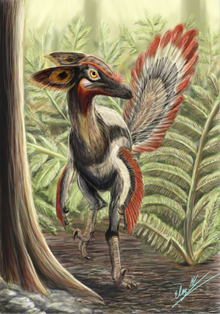
Troodontidae is a family of bird-like theropod dinosaurs. During most of the 20th century, troodontid fossils were few and incomplete and they have therefore been allied, at various times, with many dinosaurian lineages. More recent fossil discoveries of complete and articulated specimens, have helped to increase understanding about this group. Anatomical studies, particularly studies of the most primitive troodontids, like Sinovenator, demonstrate striking anatomical similarities with Archaeopteryx and primitive dromaeosaurids, and demonstrate that they are relatives comprising a clade called Paraves.
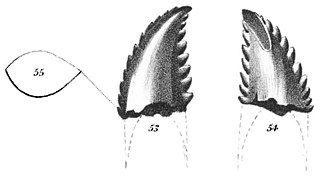
Troodon is a former wastebasket taxon and a potentially dubious genus of relatively small, bird-like dinosaurs known definitively from the Campanian age of the Cretaceous period. It includes at least one species, Troodon formosus, known from Montana. Discovered in October 1855, T. formosus was among the first dinosaurs found in North America, although it was thought to be a lizard until 1877. Several well-known troodontid specimens from the Dinosaur Park Formation in Alberta were once believed to be members of this genus. However, recent analyses in 2017 have found the genus to be undiagnostic and referred some of these specimens to the genus Stenonychosaurus and others to the genus Latenivenatrix.

Dilong is a genus of basal tyrannosauroid dinosaur. The only species is Dilong paradoxus. It is from the Lower Cretaceous Yixian Formation near Lujiatun, Beipiao, in the western Liaoning province of China. It lived about 126 million years ago.

Mei is a genus of duck-sized troodontid dinosaur first unearthed by paleontologists from the Yixian Formation in Liaoning, China in 2004. Mei lived during the Early Cretaceous period. The binomial name of its only species, Mei long, means sleeping dragon.

Saurornithoides is a genus of troodontid maniraptoran dinosaur, which lived during the Late Cretaceous period. These creatures were predators, which could run fast on their hind legs and had excellent sight and hearing. The name is derived from the Greek stems saur~ (lizard), ornith~ (bird) and eides (form), referring to its bird-like skull.
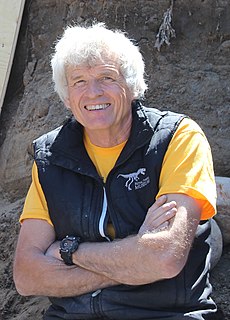
Philip John Currie is a Canadian palaeontologist and museum curator who helped found the Royal Tyrrell Museum of Palaeontology in Drumheller, Alberta and is now a professor at the University of Alberta in Edmonton. In the 1980s, he became the director of the Canada-China Dinosaur Project, the first cooperative palaeontological partnering between China and the West since the Central Asiatic Expeditions in the 1920s, and helped describe some of the first feathered dinosaurs. He is one of the primary editors of the influential Encyclopedia of Dinosaurs, and his areas of expertise include theropods, the origin of birds, and dinosaurian migration patterns and herding behavior. He was one of the models for palaeontologist Alan Grant in the film Jurassic Park.

Sinornithoides is a genus of troodontid theropod dinosaurs containing the single species Sinornithoides youngi. S. youngi lived during the Early Cretaceous. It measured approximately one meter long (3.3 ft). It lived in Inner Mongolia, China, and probably ate invertebrates and other small prey. They lived in what is now Mongolia, which was part of Laurasia.
Polyodontosaurus is a potentially dubious genus of troodontid dinosaur named in 1932 by Charles W. Gilmore for a left dentary from the Dinosaur Park Formation. It had been considered a synonym of Stenonychosaurus or Troodon for a significant time, before being declared a nomen dubium. The only known species is the type, P. grandis.

Sinovenator is a genus of troodontid dinosaur from China. It is from the early Cretaceous Period.

Sinusonasus is a genus of dinosaurs from the Early Cretaceous Period, recovered from the Yixian Formation. It lived in what is now the Liaoning Province of China. Sinusonasus was a theropod, specifically a troodontid dinosaur.

Tsaagan is a genus of dromaeosaurid dinosaur from the Djadokhta Formation of the Late Cretaceous of Mongolia.

Mahakala is a genus of halszkaraptorine theropod dinosaur from the Campanian-age Upper Cretaceous Djadokhta Formation of Ömnögovi, Mongolia. It is based on a partial skeleton found in the Gobi Desert. Mahakala was a small Dromaeosaurid, and its skeleton shows features that are also found in early Troodontids and Avialans. Despite its late appearance, it is among the most basal Dromaeosaurids. Its small size, and the small size of other basal Deinonychosaurians, suggests that small size appeared before flight capability in birds.
The Bayan Mandahu Formation is a geological unit of "redbeds" located near the village of Bayan Mandahu in Inner Mongolia, China Asia and dates from the late Cretaceous Period. Laid down in the Campanian, it is dated somewhat uncertainly to between 75 and 71 mya.

Zanabazar is a genus of large troodontid dinosaurs from the Late Cretaceous of Mongolia. The genus was originally named by Rinchen Barsbold as the new species Saurornithoides junior. In 2009 it was reclassified as its own genus and species, Zanabazar junior, named after the first spiritual figurehead of Tibetan buddhism, Zanabazar. The holotype includes a skull, vertebrae, and right hindlimb. Zanabazar was one of the largest and most derived troodontids.
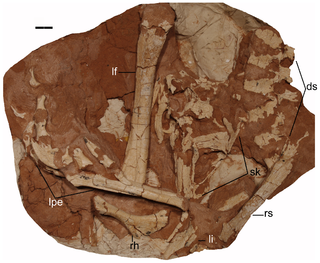
Linhevenator is a genus of short-armed troodontid theropod dinosaur from the Late Cretaceous (Campanian) Bayan Mandahu Formation of Bayan Mandahu, Inner Mongolia, China.

Wulatelong is an extinct genus of basal oviraptorid dinosaur known from the Late Cretaceous Wulansuhai Formation of Bayan Mandahu, Linhe District of Inner Mongolia, northern China. It contains a single species, Wulatelong gobiensis.
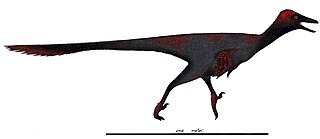
Gobivenator is an extinct genus of troodontid theropod dinosaur known from the late Campanian Djadokhta Formation of central Gobi Desert, Mongolia. It contains a single species, Gobivenator mongoliensis. G. mongoliensis is known from a single individual, which represents the most complete specimen of a Late Cretaceous troodontid currently known.

This timeline of troodontid research is a chronological listing of events in the history of paleontology focused on the troodontids, a group of bird-like theropod dinosaurs including animals like Troodon. Troodontid remains were among the first dinosaur fossils to be reported from North America after paleontologists began performing research on the continent, specifically the genus Troodon itself. Since the type specimen of this genus was only a tooth and Troodon teeth are unusually similar to those of the unrelated thick-headed pachycephalosaurs, Troodon and its relatives would be embroiled in taxonomic confusion for over a century. Troodon was finally recognized as distinct from the pachycephalosaurs by Phil Currie in 1987. By that time many other species now recognized as troodontid had been discovered but had been classified in the family Saurornithoididae. Since these families were the same but the Troodontidae named first, it carries scientific legitimacy.

Jianianhualong is a genus of troodontid theropod dinosaur from the Early Cretaceous of China. It contains a single species, Jianianhualong tengi, named in 2017 by Xu Xing and colleagues based on an articulated skeleton preserving feathers. The feathers at the middle of the tail of Jianianhualong are asymmetric, being the first record of asymmetrical feathers among the troodontids. Despite aerodynamic differences from the flight feathers of modern birds, the feathers in the tail vane of Jianianhualong could have functioned in drag reduction whilst the animal was moving. The discovery of Jianianhualong supports the notion that asymmetrical feathers appeared early in the evolutionary history of the Paraves.
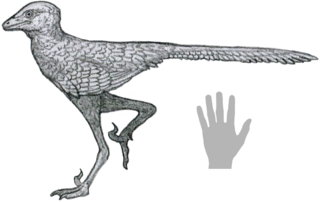
Liaoningvenator is a genus of troodontid theropod dinosaur from the Early Cretaceous of China. It contains a single species, L. curriei, named after paleontologist Phillip J. Currie in 2017 by Shen Cai-Zhi and colleagues from an articulated, nearly complete skeleton, one of the most complete troodontid specimens known. Shen and colleagues found indicative traits that placed Liaoningvenator within the Troodontidae. These traits included its numerous, small, and closely packed teeth, as well as the vertebrae towards the end of its tail having shallow grooves in place of neural spines on their top surfaces.
